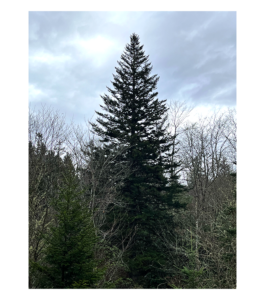Every year, the United States ForestService provides a tree from a national park to be placed on the lawn of the U.S. Capitol throughout the holiday season as “The People’s Tree”. This year, the USFS selected a 78-foot red spruce tree that was harvested from the Pisgah National Forest in North Carolina. After the harvest, the tree took a 14-day long tour from Pisgah National Forest to Washington, D.C., where it was adorned with handmade ornaments before the annual lighting ceremony on November 29th. Advocates hope that displaying the red spruce, affectionately named “Ruby”, will bring attention to the much-needed conservation efforts for spruce trees in southern Appalachia.
 Not far from where this year’s tree was harvested, Southern Highlands Reserve, a small nonprofit native plant garden and research center, sits atop Toxaway Mountain. The team at SHR, led by executive director and CED alum Kelly Holdbrooks (MLA ‘12), strives to preserve threatened species in this area by implementing strategic conservation efforts. In regard to a red spruce being selected for this year’s Capitol Christmas Tree, Holdbrooks says, “This is an incredible opportunity to shine a national spotlight on the importance of red spruce and the role they play in one of the rarest ecosystems in the United States. High-elevation spruce-fir forests support so many plant and animal species, and they are the backbone for ecotourism in our region.”
Not far from where this year’s tree was harvested, Southern Highlands Reserve, a small nonprofit native plant garden and research center, sits atop Toxaway Mountain. The team at SHR, led by executive director and CED alum Kelly Holdbrooks (MLA ‘12), strives to preserve threatened species in this area by implementing strategic conservation efforts. In regard to a red spruce being selected for this year’s Capitol Christmas Tree, Holdbrooks says, “This is an incredible opportunity to shine a national spotlight on the importance of red spruce and the role they play in one of the rarest ecosystems in the United States. High-elevation spruce-fir forests support so many plant and animal species, and they are the backbone for ecotourism in our region.”

Despite a relatively small team, the Reserve has managed to produce more than 10,000 red sprucetrees since 2009 and has worked with partners to plant more than 6,000 of those on public lands in Western North Carolina, Tennessee and Virginia. The reserve has an impressive 90 percent success rate of survival for its red spruce trees, which Holdbrooks attributes to using “only the hardiest seedlings and letting them mature longer before planting, so the trees will withstand winds, falling leaves and other challenges of life in the forest.”
In response to their impressive and impactful efforts, the federal government selected Southern Highlands Reserve to take the lead in red spruce restoration for the Southern Appalachian Mountains. The spruce-fir forests of this region are home to many species of plants and animals, including several that are endangered or threatened. However, these forests have struggled since the late 1800s due to a variety of factors, including logging, disease, pests, and climate change. The government has tasked SHR with raising 50,000 new red spruce trees to eventually be planted on public lands. To support their efforts, the Forest Service has promised $50,000 for the construction of a state-of-the-art greenhouse, a key piece in growing these red spruce seedlings. At least $200,000 will also go toward the new greenhouse, thanks to the National Forest Foundation. That greenhouse will one day house the seedlings of this year’s Capitol Christmas Tree itself, contributing to the next generation of red spruce trees to grow across the southern Appalachian region.
Due to Southern Highlands Reserve’s foundational role in red spruce restoration, Holdbrooks was invited to accompany Ruby on her journey to D.C. and was there to witness her debut on the Capitol lawn during the lighting ceremony.

Read more about the Capitol Christmas Tree Project here.
Visit Southern Highlands Reserve.
Learn more about the importance of native spruce-fir forests and sustainable forestry practices with the Southern Appalachian Spruce Restoration Initiative.

